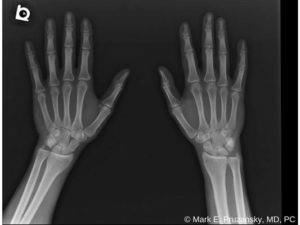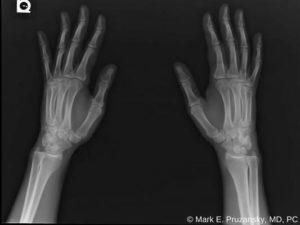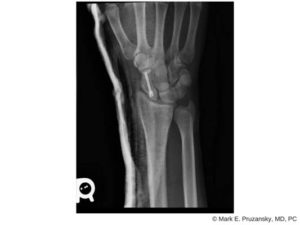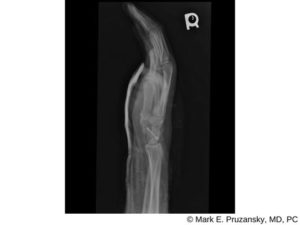Scaphoid Fractures
What is a Scaphoid Fracture?
The scaphoid is one of the eight small carpal bones in your wrist joint and is on the thumb side.

Scaphoid fracture, right, before and after percutaneous reduction and fixation
Wrist Fractures can include injuries to the scaphoid, the distal radius ulna, lunate, triquetrum, pisiform, hamate, capitate, trapezium, and trapezoid–any of the bones which comprise the wrist joint.
To identify the scaphoid bone, hold your thumb in a “thumbs up” position. You’ll find it at the base of the hollow indent made by the thumb tendons. It is here in this area that patients will typically experience pain and tenderness after a scaphoid fracture.
The scaphoid bone looks like a twisted peanut. The scaphoid is very important for normal wrist movement, motion, stability, and it is also the most common carpal bone for athletes to fracture when Falling On to a Outstretched Hand (FOOSH).
The wrist is a very complex structure because all of the small bones that make up the wrist forming many joints with the bones next to them. Ligaments then connect all the small bones to each other, and to the radius, ulna, and metacarpal bones.
Common Causes of a Scaphoid Fracture
A Scaphoid Fracture can occur from a fall onto an outstretched hand during biking, running, skiing, snowboarding, skating, football, basketball, or while walking. Car accidents can result in a scaphoid fracture as well.

Alternate view of a scaphoid fracture, right, before and after percutaneous reduction and fixation
You may also experience a radius fracture which is the larger forearm bone, depending on how your hand was positioned when you were landing and bracing for the fall.
Scaphoid fractures can happen to anyone of any age and there are no known risk factors or diseases that would make a scaphoid fracture more or less likely to occur. Wearing a wrist guard while participating in recreational activities or sports may help to decrease the chance of breaking a bone in your wrist.
Symptoms of a Scaphoid Fracture
A scaphoid fracture causes pain, swelling, bruising, stiffness, and difficulty moving the wrist.
Sometimes the pain and swelling may not be severe and the injury may be mistaken as a wrist sprain, especially if you don’t notice any deformity in the wrist like you would expect from a typical wrist fracture with displaced bones.

Additional view of a scaphoid fracture, right, before and after percutaneous reduction and fixation
The pain can be severe when you move your thumb or wrist, or when you try to pinch or grasp something. If the wrist pain doesn’t go away within a day of injury that may be indicative of a scaphoid fracture. If pain persists, make an appointment with HandSport right away to avoid any further complications. Scaphoid fractures have a hard time healing on their own.
The scaphoid bone is very important to your wrist movement and if it doesn’t heal properly you can experience long-term stiffness, and potential arthritis or debilitating wear and tear in the joint.
Diagnosing a Scaphoid Fracture
Speaking with you to understand the details of how your injury occurred is important. A careful physical exam is essential to identify the injured structure and any associated injuries. An x-ray will evaluate the scaphoid and the rest of the wrist for fracture.
The scaphoid can be fractured in different locations along the length of the bone, and knowing the location of the fracture can be important in determining optimum treatment. An MRI or CT scan will sometimes be obtained if the x-ray is not clearly demonstrating a fracture of the scaphoid, but there is still clinical concern for such an injury.

Close-up of scaphoid fracture, right, after percutaneous reduction and fixation
Treatment Options for Scaphoid Fracture
Scaphoid Fractures that just involve a crack in the bone without movement of the fractured parts away from each other (Non-displaced) can be treated usually with cast immobilization. A scaphoid fracture that has moved apart (Displaced) will benefit from arthroscopic surgery to realign the bone and insert a small screw to stabilize the fracture while it heals, as the risk of non-healing is significant in scaphoid fractures.
A scaphoid fracture at its proximal pole has a poor blood supply and may not heal with just a cast, so this kind of scaphoid fracture is a candidate for minimally invasive screw fixation. Additionally, a non-displaced scaphoid fracture can be treated with minimally invasive screw fixation as it may reduce total immobilization time and non-union rates and lead to a shorter convalescence. This may be an attractive alternative for athletes and other individuals.
A chronic scaphoid fracture that has not healed may be treated with surgery involving screw fixation and vascularized bone graft to generate healing.

Alternative close-up of scaphoid fracture, right, after percutaneous reduction and fixation
A bone stimulator can be considered as an adjunct to aid healing. An imperceptible magnetic field is applied for a time period every day.
Conclusion
A Scaphoid Fracture requires prompt diagnosis and treatment to obtain adequate healing, as the bone’s weak blood supply can lead to non-healing and arthritis of the wrist joint. Call Dr. Pruzansky at 212-249-8700 to schedule an appointment.



